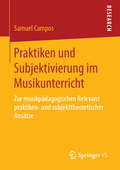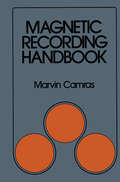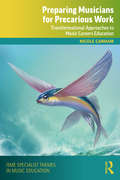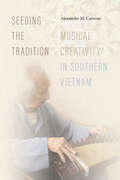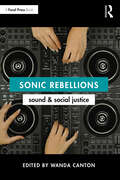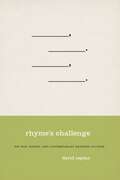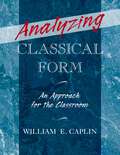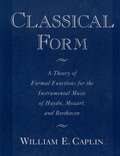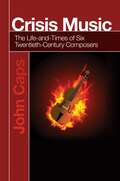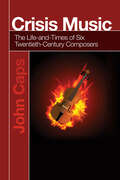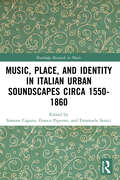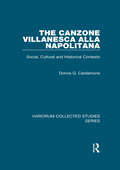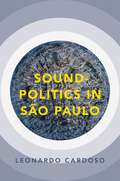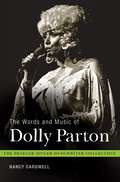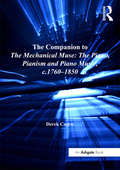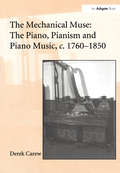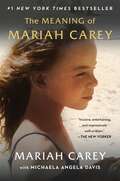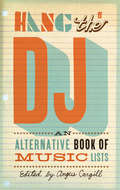- Table View
- List View
Praktiken und Subjektivierung im Musikunterricht: Zur musikpädagogischen Relevanz praktiken- und subjekttheoretischer Ansätze
by Samuel CamposAuf welche Weise konstituieren sich Subjekte im Musikunterricht? Die Studie nähert sich dieser Frage zunächst aus einer theoretischen Perspektive: Durch die Einnahme einer subjekt- und praktikentheoretischen Perspektive findet eine kritische Auseinandersetzung mit dem Begriff der Musikpraxis statt. Ausgehend von einer Analyse musikpädagogischer Praxisbegriffe erfolgt eine Rekonstruktion der mit ihnen jeweils verknüpften Subjektbegriffe. Vor dem Hintergrund poststrukturalistischer Ansätze eines „dezentrierten Subjekts“ wird schließlich eine subjekt- und praktikentheoretische Heuristik auf Musikpraxis entwickelt. Die Praktiken der Musikpraxis werden im empirischen Teil anhand einer Untersuchung von vier videografierten Unterrichtsszenen als Schauplatz von Subjektivierungsprozessen rekonstruiert. Musikpraxis wird als soziales Geschehen verstanden, in welchem sich Subjekte wechselseitig durch den konkreten Vollzug sozialer Praktiken hervorbringen. Hierdurch erlernen sich die Akteure als Subjekte des Musikunt
Preparing Musicians for Precarious Work: Transformational Approaches to Music Careers Education (ISME Series in Music Education)
by Nicole CanhamPreparing Musicians for Precarious Work: Transformational Approaches to Music Careers Education promotes career counselling-informed techniques that encourage and guide musicians to drive their careers in necessary new directions. In exposing the ‘dark side’ of precarious work in the arts sector, these approaches acknowledge the high levels of risk many musicians face and focus on the fundamental and urgent skills they need to navigate uncertainty and hardship. The author calls for a greater recognition of the psychological magnitude of managing such work, drawing upon training as a career counsellor and the lived experience of a career musician to advance transformative learning principles as pathways for artists, students, and educators alike. Representing a radical shift from the content-knowledge approach to career development, a counselling-informed method is fortified by a broad range of ideas from vocational psychology and narrative therapy, emphasising the importance of change readiness and flexible identities while identifying the need for a post-portfolio paradigm. Preparing Musicians for Precarious Work proposes a new model for musicians’ career learning – the CHOICE model – in a timely and practical guide for 21st-century musicians looking to future-proof their careers.
Preparing Musicians for Precarious Work: Transformational Approaches to Music Careers Education (ISME Series in Music Education)
by Nicole CanhamPreparing Musicians for Precarious Work: Transformational Approaches to Music Careers Education promotes career counselling-informed techniques that encourage and guide musicians to drive their careers in necessary new directions. In exposing the ‘dark side’ of precarious work in the arts sector, these approaches acknowledge the high levels of risk many musicians face and focus on the fundamental and urgent skills they need to navigate uncertainty and hardship. The author calls for a greater recognition of the psychological magnitude of managing such work, drawing upon training as a career counsellor and the lived experience of a career musician to advance transformative learning principles as pathways for artists, students, and educators alike. Representing a radical shift from the content-knowledge approach to career development, a counselling-informed method is fortified by a broad range of ideas from vocational psychology and narrative therapy, emphasising the importance of change readiness and flexible identities while identifying the need for a post-portfolio paradigm. Preparing Musicians for Precarious Work proposes a new model for musicians’ career learning – the CHOICE model – in a timely and practical guide for 21st-century musicians looking to future-proof their careers.
Seeding the Tradition: Musical Creativity in Southern Vietnam (Music / Culture)
by Alexander M. CannonFor artists, creativity plays a powerful role in understanding, confronting, and negotiating the crises of the present. Seeding the Tradition explores conflicting creativities in traditional music in Hõ Chí Minh City, the Mekong Delta, and the Vietnamese diaspora, and how they influence contemporary southern Vietnamese culture. The book centers on the ways in which musicians of đón ca tài tù, a "music for diversion," practice creativity or sáng tạo in early 21st-century southern Vietnam. These musicians draw from long-standing theories of primarily Daoist creation while adopting strategically from and also reacting to a western neo-liberal model of creativity focused primarily—although not exclusively—on the individual genius. They play with metaphors of growth, development, and ruin to not only maintain their tradition but keep it vibrant in the rapidly-shifting context of modern Vietnam. With ethnographic descriptions of zither lessons in Hõ Chi Minh City, outdoor music cafes in Cãn Thơ, and television programs in Đõng Tháp, Seeding the Tradition offers a rich description of southern Vietnamese sáng tạo and suggests revised approaches to studying creativity in contemporary ethnomusicology.
Sonic Rebellions: Sound and Social Justice
by Wanda CantonSonic Rebellions combines theory and practice to consider contemporary uses of sound in the context of politics, philosophy, and protest, by exploring the relationship between sound and social justice, with particular attention to sonic methodologies not necessarily conceptualised or practiced in traditional understandings of activism.An edited collection written by artists, academics, and activists, many of the authors have multidimensional experiences as practitioners themselves, and readers will benefit from never-before published doctoral and community projects, and innovative, audio-based interpretations of social issues today. Chapters cover the use of soundscapes, rap, theatre, social media, protest, and song, in application to contemporary socio-political issues, such as gentrification, neoliberalism, criminalisation, democracy, and migrant rights. Sonic Rebellions looks to encourage readers to become, or consider how they are, Sonic Rebels themselves, by developing their own practices and reflections in tandem to continue the conversation as to how sound permeates our sociopolitical lives.This is an essential resource for those interested in how sound can change the world, including undergraduates and postgraduates from across the social sciences and humanities, scholars and instructors of sound studies and sound production, as well as activists, artists, and community organisers.
Rhyme's Challenge: Hip Hop, Poetry, and Contemporary Rhyming Culture
by David CaplanRhyme's Challenge offers a concise, pithy primer to hip-hop poetics while presenting a spirited defense of rhyme in contemporary American poetry. David Caplan's stylish study examines hip-hop's central but supposedly outmoded verbal technique: rhyme. At a time when print-based poets generally dismiss formal rhyme as old-fashioned and bookish, hip-hop artists deftly deploy it as a way to capture the contemporary moment. Rhyme accommodates and colorfully chronicles the most conspicuous conditions and symbols of contemporary society: its products, technologies, and personalities. Ranging from Shakespeare and Wordsworth to Eminem and Jay-Z, David Caplan's study demonstrates the continuing relevance of rhyme to poetry -- and everyday life.
Rhyme's Challenge: Hip Hop, Poetry, and Contemporary Rhyming Culture
by David CaplanRhyme's Challenge offers a concise, pithy primer to hip-hop poetics while presenting a spirited defense of rhyme in contemporary American poetry. David Caplan's stylish study examines hip-hop's central but supposedly outmoded verbal technique: rhyme. At a time when print-based poets generally dismiss formal rhyme as old-fashioned and bookish, hip-hop artists deftly deploy it as a way to capture the contemporary moment. Rhyme accommodates and colorfully chronicles the most conspicuous conditions and symbols of contemporary society: its products, technologies, and personalities. Ranging from Shakespeare and Wordsworth to Eminem and Jay-Z, David Caplan's study demonstrates the continuing relevance of rhyme to poetry -- and everyday life.
Analyzing Classical Form: An Approach for the Classroom
by William E. CaplinAnalyzing Classical Form builds upon the foundations of the author's critically acclaimed Classical Form by offering an approach to the analysis of musical form that is especially suited for classroom use. Providing ample material for study in both undergraduate and graduate courses, Analyzing Classical Form presents the most up-to-date version of the author's "theory of formal functions." Students will learn how to make complete harmonic and formal analyses of music drawn from the instrumental works of Haydn, Mozart, and Beethoven. Part 1 introduces the principal theme-types of classical instrumental music; part 2 provides a methodology for analyzing sonata form, the most important formal type in this style period; and part 3 considers other full-movement forms found in this repertory (such as minuet, rondo, and concerto). The chapters are organized in a way that presents the most basic materials upfront and then leads the student through more details and finer points of theory. Every topic is illustrated with annotated musical examples; as well, the book contains many unannotated examples that can be used for in-class discussion and for out-of-class analytical exercises. A complete glossary of terms and questions for reviewing the theory will help students assimilate the many theoretical concepts employed in the book. A companion website hosted by the author at music.mcgill.ca/acf/ provides audio and musical scores for all of the examples in the book as well as additional examples for the analysis of the simple theme-types presented in part 1.
Classical Form: A Theory of Formal Functions for the Instrumental Music of Haydn, Mozart, and Beethoven
by William E. CaplinBuilding on ideas first advanced by Arnold Schoenberg and later developed by Erwin Ratz, this book introduces a new theory of form for instrumental music in the classical style. The theory provides a broad set of principles and a comprehensive methodology for the analysis of classical form, from individual ideas, phrases, and themes to the large-scale organization of complete movements. It emphasizes the notion of formal function, that is, the specific role a given formal unit plays in the structural organization of a classical work.
Classical Form: A Theory of Formal Functions for the Instrumental Music of Haydn, Mozart, and Beethoven
by William E. CaplinBuilding on ideas first advanced by Arnold Schoenberg and later developed by Erwin Ratz, this book introduces a new theory of form for instrumental music in the classical style. The theory provides a broad set of principles and a comprehensive methodology for the analysis of classical form, from individual ideas, phrases, and themes to the large-scale organization of complete movements. It emphasizes the notion of formal function, that is, the specific role a given formal unit plays in the structural organization of a classical work.
Crisis Music: The Life-and-Times of Six Twentieth-Century Composers
by John CapsStory-like chapters profile six twentieth-century reactive composers; not the most famous pillars of the period but lesser-known, perhaps more approachable, characters whose stories span that 1900-2000 period from decadent fin-de-siècle Vienna (Alban Berg, Alexander Zemlinsky) to war-torn Paris (Olivier Messiaen, Arthur Honegger) to the Cold War tensions of East vs. West (Tōru Takemitsu) and late-century Communism (Arvo Pärt). Their stories were all very different crises, and they produced very different kinds of music; each very telling of their composers life and times. Crisis Music presents each brief biography almost like a detective story looking for motives, then spotlights one particular piece of music from each composer that emerged directly out of hard times maybe a political crisis at the time of composition (Hitler marching into Paris or later Communist crack-downs); or some personal angst such as illness or scandal and how that music contains and expresses crisis. In short, the subject for discussion is how context influences content. Such troubled and especially vivid composition, crisis music, can often be most compelling and meaningful for its composer and for its time. Indeed, their music also seems to have a special resonance to share with our own crisis-prone times. And meanwhile, Western music history played-out its own story from late-romantic style to Serialism and Minimalism to the anything-goes Pluralism we hear today. Crisis Music sparks the discussion about how history, biography and music intersects. At the behest of music teachers at secondary and tertiary levels, Crisis Music contains substantive Discussion Questions geared for classroom use.
Crisis Music: The Life-and-Times of Six Twentieth-Century Composers
by John CapsStory-like chapters profile six twentieth-century reactive composers; not the most famous pillars of the period but lesser-known, perhaps more approachable, characters whose stories span that 1900-2000 period from decadent fin-de-siècle Vienna (Alban Berg, Alexander Zemlinsky) to war-torn Paris (Olivier Messiaen, Arthur Honegger) to the Cold War tensions of East vs. West (Tōru Takemitsu) and late-century Communism (Arvo Pärt). Their stories were all very different crises, and they produced very different kinds of music; each very telling of their composers life and times. Crisis Music presents each brief biography almost like a detective story looking for motives, then spotlights one particular piece of music from each composer that emerged directly out of hard times maybe a political crisis at the time of composition (Hitler marching into Paris or later Communist crack-downs); or some personal angst such as illness or scandal and how that music contains and expresses crisis. In short, the subject for discussion is how context influences content. Such troubled and especially vivid composition, crisis music, can often be most compelling and meaningful for its composer and for its time. Indeed, their music also seems to have a special resonance to share with our own crisis-prone times. And meanwhile, Western music history played-out its own story from late-romantic style to Serialism and Minimalism to the anything-goes Pluralism we hear today. Crisis Music sparks the discussion about how history, biography and music intersects. At the behest of music teachers at secondary and tertiary levels, Crisis Music contains substantive Discussion Questions geared for classroom use.
Music, Place, and Identity in Italian Urban Soundscapes circa 1550-1860 (Routledge Research in Music)
by Simone Caputo Franco Piperno Emanuele SeniciMusic, Place, and Identity in Italian Urban Soundscapes circa 1550-1860 presents new perspectives on the role music played in the physical, cultural, and civic spaces of Italian cities from the sixteenth to the nineteenth century. Across thirteen chapters, contributors explore the complex connections between sound and space within these urban contexts, demonstrating how music and sound were intimately connected to changing social and political practices. The volume offers a critical redefinition of the core concept of soundscape, considering musical practices through the lenses of territory, space, representation, and identity, in five parts: Soundscape, Phonosphere, and Urban History Urban Soundscapes across Time Urban Soundscapes and Acoustic Communities Urban Soundscapes in Literary Sources Reconstructing Urban Soundscapes in the Digital Era Music, Place, and Identity in Italian Urban Soundscapes circa 1550-1860 reframes our understanding of Italian music history beyond models of patronage, investigating how sounds and musics have contributed to the construction of human identities and communities.
The canzone villanesca alla napolitana: Social, Cultural and Historical Contexts
by Donna G. CardamoneThe printed debut of the canzone villanesca alla napolitana occurred on 24 October 1537, in Naples. Fifteen anonymous 'rustic songs' were published by Johannes de Colonia in a pocket-sized anthology with a cover featuring three women with hoes tilling the soil. The adjective villanesca (from villano or peasant) in the strict sense of the word means rustic or crude, but in this new context it also intimates that Neapolitan poet-musicians had been affected by the instinctive lyrical traditions of everyday people. The articles in this volume trace the Neapolitan origins of this song form, and its subsequent development as it spread quickly throughout Italy in a succession of editions published in Venice and Rome, providing a diverse repertory of lively songs to amuse the privileged that held and attended academies. Several studies focus on key figures in this process, notably Ferrante Sanseverino, Prince of Salerno, and Orlando di Lasso. At the same time the author relates these developments to the contemporary political context, notably the rivalry of Spain and France for control of the Kingdom of Naples.
The canzone villanesca alla napolitana: Social, Cultural and Historical Contexts
by Donna G. CardamoneThe printed debut of the canzone villanesca alla napolitana occurred on 24 October 1537, in Naples. Fifteen anonymous 'rustic songs' were published by Johannes de Colonia in a pocket-sized anthology with a cover featuring three women with hoes tilling the soil. The adjective villanesca (from villano or peasant) in the strict sense of the word means rustic or crude, but in this new context it also intimates that Neapolitan poet-musicians had been affected by the instinctive lyrical traditions of everyday people. The articles in this volume trace the Neapolitan origins of this song form, and its subsequent development as it spread quickly throughout Italy in a succession of editions published in Venice and Rome, providing a diverse repertory of lively songs to amuse the privileged that held and attended academies. Several studies focus on key figures in this process, notably Ferrante Sanseverino, Prince of Salerno, and Orlando di Lasso. At the same time the author relates these developments to the contemporary political context, notably the rivalry of Spain and France for control of the Kingdom of Naples.
Sound-Politics in São Paulo (Currents in Latin American and Iberian Music)
by Leonardo CardosoHow does the state separate music from noise? How can such a filtering apparatus shape the content and form of sound production in the city? As a marker of co-presence to the hearing body, sound is always open to (or rather opens up) the politics of shared existence. In the throes of the post-dictatorship period, Brazil's legislative and executive branches implemented a series of sweeping measures to address quality of life concerns, including environmental pollution and urban inequality. In São Paulo, noise control became a recurrent controversy, growing in size and scale between the 1990s and 2010s. Together with the much-debated fear of crime and the socioeconomic and cultural tensions between the rich urban center and the poor peripheries, such ecological agendas against noise as a harmful pollutant have reconfigured the presence of environmental sounds in the city. In this book, Cardoso argues that the framing of specific sounds as unavoidable, unnecessary, or as harmful "noise" has been an effective strategy to organize spaces and administer group behavior in this rapidly expanding city. He focuses on two interrelated processes. First, the series of institutional regulatory mechanisms that turn sounds into the all-embracing "noise" susceptible to state intervention. Second, the constant attempts of interested groups in either attaching or detaching specific sounds (musical events, industrial noise, traffic noise, religious sounds, etc.) from regulatory scrutiny. Sound-politics is the dynamic that emerges from both processes - the channels through which sounds enter (and leave) the sphere of state regulation.
SOUND-POLITICS IN SAO PAULO CILAM C (Currents in Latin American and Iberian Music)
by Leonardo CardosoHow does the state separate music from noise? How can such a filtering apparatus shape the content and form of sound production in the city? As a marker of co-presence to the hearing body, sound is always open to (or rather opens up) the politics of shared existence. In the throes of the post-dictatorship period, Brazil's legislative and executive branches implemented a series of sweeping measures to address quality of life concerns, including environmental pollution and urban inequality. In São Paulo, noise control became a recurrent controversy, growing in size and scale between the 1990s and 2010s. Together with the much-debated fear of crime and the socioeconomic and cultural tensions between the rich urban center and the poor peripheries, such ecological agendas against noise as a harmful pollutant have reconfigured the presence of environmental sounds in the city. In this book, Cardoso argues that the framing of specific sounds as unavoidable, unnecessary, or as harmful "noise" has been an effective strategy to organize spaces and administer group behavior in this rapidly expanding city. He focuses on two interrelated processes. First, the series of institutional regulatory mechanisms that turn sounds into the all-embracing "noise" susceptible to state intervention. Second, the constant attempts of interested groups in either attaching or detaching specific sounds (musical events, industrial noise, traffic noise, religious sounds, etc.) from regulatory scrutiny. Sound-politics is the dynamic that emerges from both processes - the channels through which sounds enter (and leave) the sphere of state regulation.
The Words and Music of Dolly Parton: Getting to Know Country's "Iron Butterfly" (The Praeger Singer-Songwriter Collection)
by Nancy CardwellThis insightful biography provides a closer look at one of the entertainment world's biggest stars, with a focus on what got her to the top—and what has kept her there.Dolly Parton has an enviable record of accomplishment as a performer, songwriter, recording artist, businesswoman, and philanthropist. She has triumphed on Broadway, in the movies, and even with her own theme park. The Words and Music of Dolly Parton probes its subject's unique singing voice and prolific abilities as a songwriter, as well as her impressive business savvy, fearless attitude, and an imagination as towering as the Smoky Mountains among which she grew up.This book focuses on Parton's most important albums and songwriting style, examining her career from her early days in the east Tennessee mountains through her national television exposure on the Porter Wagoner Show, her crossover success in pop music, and her return to her acoustic/bluegrass roots. In addition, it explores Parton's story songs and characters, the spirituality reflected in her music, and her important collaborations with other artists.
The Companion to The Mechanical Muse: The Piano, Pianism and Piano Music, c.1760–1850
by Derek CarewIntended as a supplement to The Mechanical Muse: The Piano, Pianism and Piano Music, c.1760-1850, this Companion provides additional information which, largely for reasons of space but also of continuity, it was not possible or desirable to include in that volume. The book is laid out alphabetically and full biographical entries are provided for all musical figures mentioned, including composers, performers, theoreticians and teachers, as well as piano makers and publishers of music, within the period covered by The Mechanical Muse. There are also entries on figures of importance from outside the period but whose influence is palpably important within it, such as J.S. Bach. As well as biographical information, all these entries contain lists of principal works and a section on further reading so that readers can follow up people and matters of particular interest. Also included in The Companion are entries devoted to particular works and other information of relevance, such as descriptions of musical forms, characteristics of dances and so on, as well as some technical information on music and explanations of technical terms pertaining to keyboard instruments themselves and to ways of playing them. This Companion is not intended to replace existing reference books such as Grove or Musik in Geschichte und Gegenwart, but will be useful for those who desire to know more about a particular topic and do not necessarily have access to more specialist reference works, or time to visit large or specialist libraries. As such it is indispensable to users of The Mechanical Muse.
The Companion to The Mechanical Muse: The Piano, Pianism and Piano Music, c.1760–1850
by Derek CarewIntended as a supplement to The Mechanical Muse: The Piano, Pianism and Piano Music, c.1760-1850, this Companion provides additional information which, largely for reasons of space but also of continuity, it was not possible or desirable to include in that volume. The book is laid out alphabetically and full biographical entries are provided for all musical figures mentioned, including composers, performers, theoreticians and teachers, as well as piano makers and publishers of music, within the period covered by The Mechanical Muse. There are also entries on figures of importance from outside the period but whose influence is palpably important within it, such as J.S. Bach. As well as biographical information, all these entries contain lists of principal works and a section on further reading so that readers can follow up people and matters of particular interest. Also included in The Companion are entries devoted to particular works and other information of relevance, such as descriptions of musical forms, characteristics of dances and so on, as well as some technical information on music and explanations of technical terms pertaining to keyboard instruments themselves and to ways of playing them. This Companion is not intended to replace existing reference books such as Grove or Musik in Geschichte und Gegenwart, but will be useful for those who desire to know more about a particular topic and do not necessarily have access to more specialist reference works, or time to visit large or specialist libraries. As such it is indispensable to users of The Mechanical Muse.
The Mechanical Muse: The Piano, Pianism and Piano Music, c.1760-1850
by Derek CarewThis book charts the piano's accession from musical curiosity to cultural icon, examining the instrument itself in its various guises as well as the music written for it. Both the piano and piano music were very much the product of the intellectual, cultural and social environments of the period and both were subject to many influences, directly and indirectly. These included character (individualism), the vernacular ('folk/popular') and creativity (improvisation), all of which are discussed generally and with respect to the music itself. Derek Carew surveys the most important pianistic genres of the period (variations, rondos, and so on), showing how these changed from their received forms into vehicles of Romantic expressiveness. The piano is also looked at in its role as an accompanying instrument. The Mechanical Muse will be of interest to anyone who loves the piano or the period, from the non-specialist to the music postgraduate.
The Mechanical Muse: The Piano, Pianism and Piano Music, c.1760-1850
by Derek CarewThis book charts the piano's accession from musical curiosity to cultural icon, examining the instrument itself in its various guises as well as the music written for it. Both the piano and piano music were very much the product of the intellectual, cultural and social environments of the period and both were subject to many influences, directly and indirectly. These included character (individualism), the vernacular ('folk/popular') and creativity (improvisation), all of which are discussed generally and with respect to the music itself. Derek Carew surveys the most important pianistic genres of the period (variations, rondos, and so on), showing how these changed from their received forms into vehicles of Romantic expressiveness. The piano is also looked at in its role as an accompanying instrument. The Mechanical Muse will be of interest to anyone who loves the piano or the period, from the non-specialist to the music postgraduate.
The Meaning of Mariah Carey
by Mariah CareyThe global icon, award-winning singer, songwriter, producer, actress, mother, daughter, sister, storyteller, and artist finally tells the unfiltered story of her life in The Meaning of Mariah Carey.It took me a lifetime to have the courage and the clarity to write my memoir. I want to tell the story of the moments - the ups and downs, the triumphs and traumas, the debacles and the dreams, that contributed to the person I am today. Though there have been countless stories about me throughout my career and very public personal life, it’s been impossible to communicate the complexities and depths of my experience in any single magazine article or a ten-minute television interview. And even then, my words were filtered through someone else’s lens, largely satisfying someone else’s assignment to define me.This book is composed of my memories, my mishaps, my struggles, my survival and my songs. Unfiltered. I went deep into my childhood and gave the scared little girl inside of me a big voice. I let the abandoned and ambitious adolescent have her say, and the betrayed and triumphant woman I became tell her side.Writing this memoir was incredibly hard, humbling and healing. My sincere hope is that you are moved to a new understanding, not only about me, but also about the resilience of the human spirit.Love,Mariah
Hang the DJ: An alternative book of music lists
by Angus Cargill'Entertaining and addictive' (Metro) Hang the DJ is the must-read book of music lists, for all true music fans. In the hearts of all music lovers there are lists - from the best break-up songs, to the best drinking songs; the perfect mix-tape to the dream set-list; Dylan's dirtiest songs, to Tom Waits' saddest. Hang the DJ compiles the sort of thing you might once have scribbled in the back of your school book: musical loves and hates, dreams and nightmares. With contributions from novelists (Ali Smith, David Peace, Jonathan Lethem, Michel Faber), musicians (Kathryn Williams, Willy Vlautin, Jeb Loy Nichols, Tom McRae) and music writers (Nick Kent, Laura Barton, Simon Reynolds, Jon Savage) this is a collection that will inspire and provoke and send you back to your music collection, to old favourites and guilty pleasures alike.
